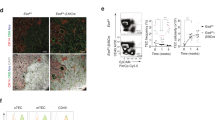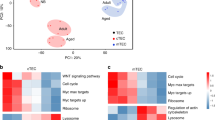Abstract
The mouse Polycomb-group gene, embryonic ectoderm development (eed), appears to regulate cellular growth and differentiation in a developmental and tissue specific manner. During embryogenesis, eed regulates axial patterning, whereas in the adult eed represses proliferation of myeloid and B cell precursors. The present report demonstrates two novel functional activities of eed: alteration of thymocyte maturation and suppression of thymic lymphoma development. Mice that inherit the viable hypomorphic 17Rn51989SB eed allele sustain a partial developmental block at or before the CD4−CD8−CD44−CD25+ stage of thymocyte differentiation. Furthermore, mice that are homozygous or heterozygous for the hypomorphic eed allele have an increased incidence and decreased latency of N-methyl-N-nitrosourea-induced thymic lymphoma compared to wild-type littermates. These findings support the notion that Polycomb-group genes exert pleiotrophic effects dictated by developmental stage and cellular context.
This is a preview of subscription content, access via your institution
Access options
Subscribe to this journal
Receive 50 print issues and online access
$259.00 per year
only $5.18 per issue
Buy this article
- Purchase on Springer Link
- Instant access to full article PDF
Prices may be subject to local taxes which are calculated during checkout




Similar content being viewed by others
References
Akasaka T, Kanno M, Balling R, Miesa MA, Taniguchi M, Koseki H . 1996 Development 122: 1513–1522
Alkema MJ, Bronk M, Verhoeven E, Otte AP, van't Veer LJ, Berns A, van Lohuizen M . 1997 Genes Dev. 11: 226–240
Angel JM, Morizot DC, Richie ER . 1989 J. Natl. Cancer Inst. 81: 1652–1655
Angel JM, Morizot DC, Richie ER . 1993 Mol. Carcinog. 7: 151–156
Bain G, Engel I, Robanus Maandag E, Hein PJ, te Riele HPJ, Voland JR, Sharp LL, Chun J, Huey B, Pinkel D, Murre C . 1997 Mol. Cell. Biol. 17: 4782–4791
Denisenko ON, Bomsztyk K . 1997 Mol. Cell. Biol. 17: 4707–4717
Denisenko ON, Shnyreva M, Suzuki H, Bomsztyk K . 1998 Mol. Cell. Biol. 18: 5634–5642
Faust C, Lawson KA, Schork NJ, Thiel B, Magnuson T . 1998 Development 125: 4495–4506
Faust C, Schumacher A, Holdener B, Magnuson T . 1995 Development 121: 273–285
Fehling HJ, Von Boehmer H . 1997 Curr. Opin. Immunol. 9: 263–275
Frei JV . 1980 Carcinogenesis 1: 721–723
Frei JV, Maitra SC . 1974 Chem. Biol. Interactions 9: 65–69
Godfrey DI, Kennedy J, Mombaerts P, Tonegawa S, Zlotnik A . 1994 J. Immunol. 152: 4783–4792
Godfrey DI, Kennedy J, Suda T, Zlotnik A . 1993 J. Immunol. 150: 4244–4252
Gomez G, Clarkin KZ, Kraig E, Infante AJ, Richie ER . 2000 Int. Immunol. 12: 263–270
Gunster MJ, Staijn DPE, Hamer KM, den Blaauwen DL, de Bruijn D, Alkema JJ, van Lohuizen M, van Driel R, Otte AP . 1997 Mol. Cell. Biol. 17: 2326–2335
Gutjahr T, Frei E, Spicer C, Baumgartner S, White RAH, Noll M . 1995 EMBO J. 14: 4296–4306
Hunter T . 1991 Cell 64: 249–270
Jacobs JJL, Kieboom K, Marino S, DePinho RA, van Lohuizen M . 1999 Nature 397: 164–168
Kung AL, Rebel VI, Bronson RT, Ch'ng L-E, Sieff CA, Livingston DM, Yao T-P . 2000 Genes Dev. 14: 272–277
Lessard H, Schumacher A, Thorsteinsdottir U, van Lohuizen M, Magnuson T, Sauvageau G . 1999 Genes Dev. 13: 2691–2703
Malissen M, Minard K, Mjolsness S, Kronenberg M, Goverman J, Hunkapiller T, Prystowsky MB, Yoshikai Y, Fitch F, Mak TW, Hood L . 1984 Cell 37: 1101–1110
Newcomb EW, Steinber JJ, Pellicer A . 1988 Cancer Res. 48: 5514–5521
Ng J, Li R, Morgan K, Simon J . 1997 Mol. Cell. Biol. 17: 6663–6672
Richie E . 1988 Leukemia Res. 12: 233–242
Richie ER, Angel JM, Rinchik EM . 1996 Prog. Clin. Biol. Res. Slaga TJ (ed) Wiley-Liss, Inc.: New York, NY pp. 23–32
Rinchik EM, Carpenter DA . 1993 Mamm. Genome 4: 349–353
Rinchik EM, Carpenter DA, Selby PB . 1990 Proc. Natl. Acad. Sci. USA 87: 896–900
Rodewald H-R, Fehling HJ . 1998 Adv. Immunol. 69: 1–112
Romach E, Moore JL, Rummel S, Richie ER . 1994 Carcinogenesis 15: 2275–2280
Sathe SS, Harte PJ . 1995 Mech. Dev. 52: 77–87
Satijn DPE, Gunster MJ, van der Vlag J, Hamer KM, Schul W, Alkema MJ, Saurin AJ, Freemont PS, van Driel R, Otte AP . 1999 Mol. Cell. Biol. 17: 4105–4113
Schumacher A, Faust C, Magnuson T . 1996 Nature 383: 250–253
Schumacher A, Lichtarge O, Schwartz S, Magnuson T . 1998 Genomics 54: 79–88
Sewalt RG, van der Vlag J, Gunster MJ, Hamer KM, den Blaauwen JL, Staijn DPE, Hendrix T, van Driel R, Otte AP . 1998 Mol. Cell. Biol. 18: 3586–3595
Simon J . 1995 Curr. Opin. Cell Biol. 7: 376–385
Simon J, Bornemann D, Lunde K, Schwartz C . 1995 Mech. Dev. 53: 197–208
Stettner SL, Rummel SA, Conti CJ, Richie ER . 1991 Cancer Res. 51: 737–740
Struhl G, Brower D . 1982 Cell 31: 285–292
van der Lugt NMT, Domen J, Linders K, van Roon M, Robanus-Maandag E, Riele H, van der Valk M, Deschamps J, Sofroniew M, van Lohuizen M, Berns A . 1994 Genes Dev. 8: 757–769
van der Vlag J, Otte AP . 1999 Nature Genet. 23: 474–478
van Lohuizen M, Tijms M, Vonchen JW, Schumacher A, Magnuson T, Wientjens E . 1998 Mol. Cell. Biol. 18: 3572–3579
Weinberg RA . 1991 Science 254: 1138
Winandy S, Wu P, Georgopoulos K . 1995 Cell 83: 289–299
Zaidi NH, Allay E, Ayi TC, Li BFL, Dumenco LL, Sy MS, Gerson SL . 1995 Carcinogenesis 16: 1047–1053
Acknowledgements
This work was supported in part by ACS grant RPG-93-002-04-CN, NIEHS Center Grant ES07784, M.D. Anderson Core Grant CA16672, and a Bruce McMillan, Jr., Fdn. grant to ER Richie; NHGRI grant HG00370 and The Department of Energy BER Program under contract DE-AC 05-96OR22464 with Lockheed Martin Energy Research Corp. to EM Rinchik; and HD24462 to T Magnuson. The authors are grateful to Dr Lezlee Coghlan and Dale Weiss for maintenance of the animal colony at SPRD. We also thank Dr John Repass for PCR analysis, Dr Dennis Johnston for performing the statistical analyses and Carrie McKinley for assistance with manuscript preparation.
Author information
Authors and Affiliations
Corresponding author
Rights and permissions
About this article
Cite this article
Richie, E., Schumacher, A., Angel, J. et al. The Polycomb-group gene eed regulates thymocyte differentiation and suppresses the development of carcinogen-induced T-cell lymphomas. Oncogene 21, 299–306 (2002). https://doi.org/10.1038/sj.onc.1205051
Received:
Revised:
Accepted:
Published:
Issue Date:
DOI: https://doi.org/10.1038/sj.onc.1205051
Keywords
This article is cited by
-
Loss of microglial EED impairs synapse density, learning, and memory
Molecular Psychiatry (2022)
-
Maintaining cell identity: PRC2-mediated regulation of transcription and cancer
Nature Reviews Cancer (2016)
-
Polycomb-group proteins in hematopoietic stem cell regulation and hematopoietic neoplasms
Leukemia (2013)
-
Epigenetic plasticity of chromatin in embryonic and hematopoietic stem/progenitor cells: therapeutic potential of cell reprogramming
Leukemia (2008)
-
Epigenetic regulation of normal and malignant hematopoiesis
Oncogene (2007)



